These ten respectably (though not overly generously) filled discs are, perhaps
inevitably, a mixed blessing but blessing they remain and this long benediction
often surprises and astounds.
The vintage of the recordings in boxes 1 and 2 varies from well known concert
performances from 1965 when a clutch of concerts given at the Moscow
Conservatoire were recorded and issued for commercial consumption to radio
broadcasts from the seventies and eighties. Volume two also has quite a few
commercial recordings from the late 1940s and the 1950s. These have appeared
previously on EMI LPs and latterly (1980s) on Olympia CDs. Most of the discs
are sourced from tapes of the Leningraders on their own soil.
Some of the performances, as in Box 1, are taken from live concerts given
in Leningrad (now St Petersburg) and Moscow. The trade-off for concert-hall
ambience and some striking high voltage playing and insight is a light speckling
of coughs or in a very few cases a staggered barrage of coughing. Too much
can be made of this. For my part I would rather suffer audience noise than
forego the patent awe that suffuses so much of this making of music.
The notes (English, German and French) are by the always excellent Dr Sigrid
Neef and the translations are idiomatic. What I especially like about the
notes is that the work-specific sections link commentary about the work directly
with Mravinsky's performance history and his philosophy about these composers.
The numbering of the volumes carries over from the first box which includes
vols 1-10.
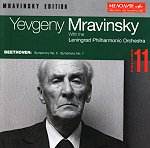
Vol 11 BEETHOVEN
Beethoven's Symphonies 5 and 7 are presented with typical iron-crease precision
and high emotional temperature. Recording quality in the 1949 fifth symphony
tape is as expected - rather ancient - but it still has the power to communicate.
Neither will be regarded as library shelf standards but for my part I would
rather get to know these works from this disc than I would from a probably
plusher modern production. There is no sense of routine in this music making.
I wonder if Mravinsky ever recorded Eroica? Now that I would like to hear.
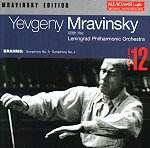
Vol 12 BRAHMS
Leaping forward to 1972 and 1973, Symphonies 3 and 4 join the disc of No
2 in the first box. It is a pity that there is not an available tape of No.
1 - a work completely in tune with Mravinsky's intensity. Similar qualities
bless these performances and recordings. Mravinsky and the Leningrad orchestra
(what a delight that BMG resisted redubbing it the St Petersburg in what
would have been a curious inversion of '1984' rewriting of history) do not
distort. There are no incongruities. The blaze on the brass sound seems
completely in keeping. The strings are precise and generously toned. At the
same time the tragic edge in both symphonies is presented with conviction
borne of experience. Both performances are live not studio.
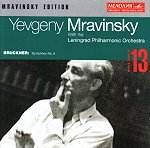
Vol. 13 BRUCKNER Symphony No 8 rec
1959 mono
At 73.59 this must surely be a cut version. Nevertheless what is caught in
this, the towering climax of the Bruckner cycle, is the blooming dark tragedy
of the work and of course Mravinsky is fully sympathetic to that mood. This
is one of the strengths of this set.
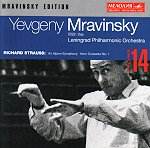
Vol. 14 RICHARD STRAUSS
I had not expected a Strauss collection, least of all the tottering awe of
the Alpine Symphony. What comes over eloquently in the Alpine is less of
the 'kolossal' and more of the ecstasy of Alpine pastures. The First Horn
Concerto is a favourite of mine and is the only concerto in the two boxes.
It is exuberantly done by Vitaly Buyanovsky. The tapes date from the early
1960s and must be of live concert performances judging by the occasional
coughs.
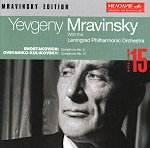
VOL. 15 OVSYANIKO-KULIKOVSKY and
SHOSTAKOVICH
The inconsequential symphony no. 21 by Nikolai Ovsyaniko-Kulikovsky is a
fake written by one Michael Goldstein (where is he now?) who is given to
perpetrating such counterfeits. He has also written a cello sonata by Borodin!
The symphony is coupled with a ragged but typically excoriating performance
of the Shostakovich 5. Both tapes date from 1954 and like others in this
set are in mono.
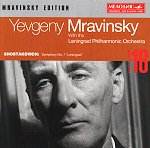
VOL 16 SHOSTAKOVICH
This work (Symphony No. 7) is much more than the primary colours propaganda
poster it is sometimes condemned as. Its long Adagio throbs with tragic power
and its wartime origins smoke and smoulder through every bar. As expected
Mravinsky is completely in touch with this music and a compelling and bruising
power burns through and through. The 1953 recording was made in Leningrad
probably by an orchestra many of whose members remembered the terrible days
of 1941.
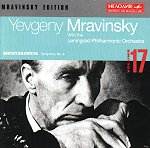
VOL. 17 SHOSTAKOVICH
The Eighth Symphony (1943) is another avowedly wartime work. This symphony
is dedicated to Mravinsky. It is tough, pugnacious and tragic and very much
in keeping with Mravinsky's temperament. The mono recording from 1947 is
primitive but communicative. Hardly a definitive choice but one that it is
a pleasure to know exists.
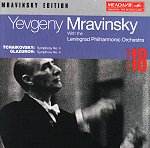
VOL 18 TCHAIKOVSKY and
GLAZUNOV
Two fourth symphonies. Glazunov's is comparatively rare (a pity there weren't
more Glazunovs in this set - I would have liked to have heard Glazunov 5,
6, 7 and 8 from Mravinsky). Here its pastoral pleasures and Kouchka-like
romance are well handled and make a contrast with the straining drama of
Tchaikovsky 4. Both tapes are mono dating from 1957 (Tchaikovsky) and 1948
(Glazunov).
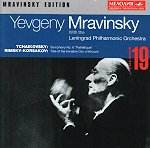
VOL 19 TCHAIKOVSKY and
RIMSKY-KORSAKOV
Rather like the last volume, two traditions meet in this disc. The Russian
steppes romance and exoticism of Rimsky-Korsakov (Legend of the City of Kitezh
suite) and the tightly screwed up breaking strain emotionalism of Tchaikovsky's
Pathetique. Both mono tapes date from 1949.
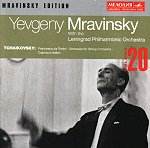
VOL. 20 TCHAIKOVSKY - all mono tapes
Francesca da Rimini is work ideally suited to Mravinsky's sense of theatre
and passion. It is excellently done here with a volcanic spirit hindered
not a whit by the 1948 recording quality. The 1949 sourced tape of the Serenade
for Strings provides a lilting contrast with the blood, passion and gore
of Francesca. Finally Tchaikovsky's circus ring postcard (Capriccio Italien)
is done with crude eagerness in a 1950 tape.
SUMMARY
This set, with older recordings than box 1, has much to commend it but if
it comes to a choice between having Box 1 or Box 2 I would go for the more
consistently glowing splendours of Box 1. At the same time you will look
wistfully over your shoulder at Box 2.
Reviewer
Rob Barnett


